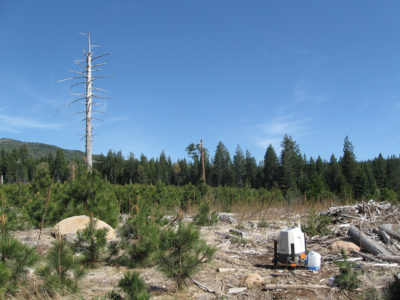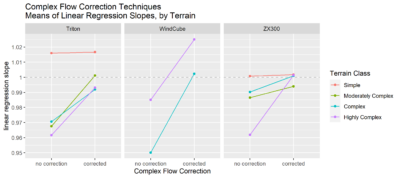Independent expert study on Remote Sensing Devices confirms ZX 300 wind Lidar accuracy in all classes of complex terrain
 26 October 2020: The Consortium for the Advancement of Remote Sensing (CFARS) has released its survey of Remote Sensing Devices operating in complex flow including the WindCube (Leosphere, a Vaisala company), Triton Sonic Wind Profiler (Vaisala) and ZX 300 (ZX Lidars).
26 October 2020: The Consortium for the Advancement of Remote Sensing (CFARS) has released its survey of Remote Sensing Devices operating in complex flow including the WindCube (Leosphere, a Vaisala company), Triton Sonic Wind Profiler (Vaisala) and ZX 300 (ZX Lidars).
Ground-based Lidars and Sodars employ a variety of beam probing or scan patterns by which the horizontal wind speed, vertical wind speed and wind direction are derived – all assume homogeneous flow conditions within the scan / beam volume. In contrast, traditional meteorological masts equipped with cup anemometers provide a single measurement at the installation point of the sensor. In complex flow, often caused by terrain and fixed objects, the assumption of homogeneous flow conditions within the measurement volume introduces differences between lidar and cup anemometer. In situations like this a flow conversion technique can be applied.
CFARS have compared the various techniques adopted when using a WindCube, Triton and ZX 300 remote sensor and presented the following analysis of the accuracy of each device pre- and post-conversion / correction of data to account for the complex flow:

Figure 1: Presented at AWEA Wind Resource Assessment 2020. Courtesy of CFARS, A. Black, M. Debnath, A. Lammers, P. Mazoyer, R. Schultz, T. Spaulding, S. Wylie
Across a broad range of cases previously published by ZX Lidars and Meteodyn incorporating 13 different wind project locations, data presented confirmed that CFD conversion of ZX 300 data in non-homogeneous flow conditions produced excellent agreement with collocated anemometry. As a result the data can be considered as finance-grade in situation.
With regards to the range of terrain classes as defined by [Bingöl et al., 2009][1]. ZX 300 was also shown to perform to high levels of accuracy in all conditions including even highly complex sites:

Figure 2: Presented at AWEA Wind Resource Assessment 2020. Courtesy of CFARS, A. Black, M. Debnath, A. Lammers, P. Mazoyer, R. Schultz, T. Spaulding, S. Wylie
ZX 300 performance in complex flow is achieved by its unique 50 Line of Sight measurements in just 1-second. From this baseline performance, the use of additional Complex Flow tools available from a range of service providers including WindSim, Meteodyn and Natural Power are able to optimize the performance of ZX 300 further, delivering results that are traceable and auditable with a published conversion process.
Breaking News: ZX Lidars has continued to collaborate in this application. Following a successful development and validation programme by computational wind engineering company ZephyScience and independent wind consultancy Deutsche WindGuard, a further data conversion technique ‘ZX CFR’ (Complex Flow Resolver) has now also demonstrated results to known and acceptable uncertainties allowing ZX Lidar systems to be deployed standalone in complex terrain and deliver wind speed and wind direction measurements that can be included within Energy Yield Assessments (EYAs) and Site Suitability Assessments (SA). Full details of ZX CFR are expected to be released in November 2020.
About ZX Lidars (formerly ZephIR Lidar)
ZX Lidars provides industry-leading wind lidar products, ZX 300, ZX 300M and ZX TM for wind energy and meteorological applications. These Lidars deliver accurate wind measurements in both onshore and offshore applications at measurement heights / ranges across the full swept area of the blades of modern wind turbines, and beyond. With more than 10 million hours of operation in the field and over 1000 deployments (and counting), ZX Lidars has pioneered the use of Lidar in the wind industry. The company is proud of the many world firsts it has achieved with customers including: upwind measurements from a turbine nacelle, turbine wake studies, offshore deployments of both fixed and floating wind lidar, an industry-accepted validation process, re-financing and re-powering of a wind farm, successful demonstration of measurement accuracy in a wind tunnel and total wind project financing from a lidar without need for a met mast. To find out more visit: www.zxlidars.com
[1] F. Bingöl Complex Terrain and Wind Lidars. Risø-PhD-52 (EN) August 2009
